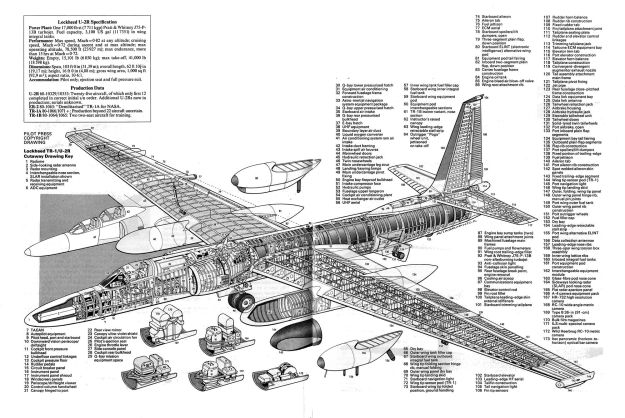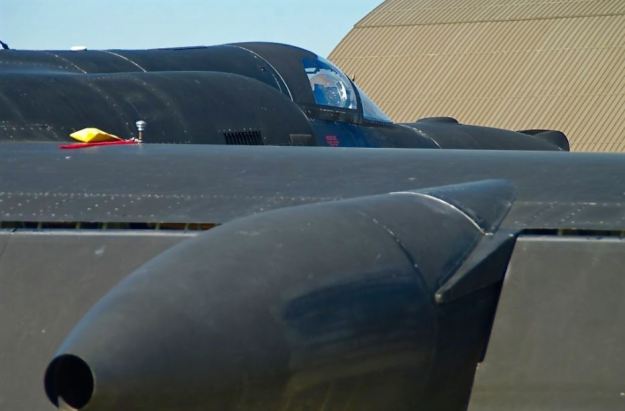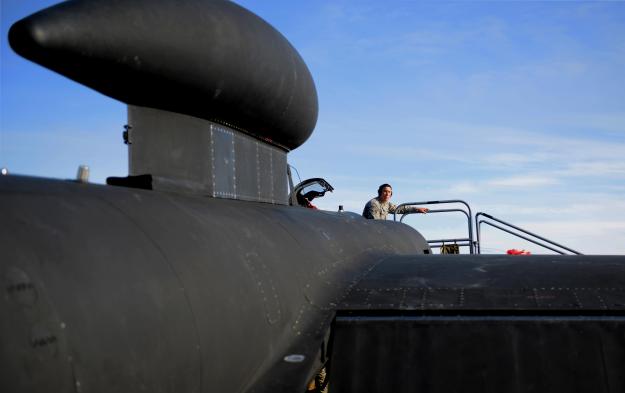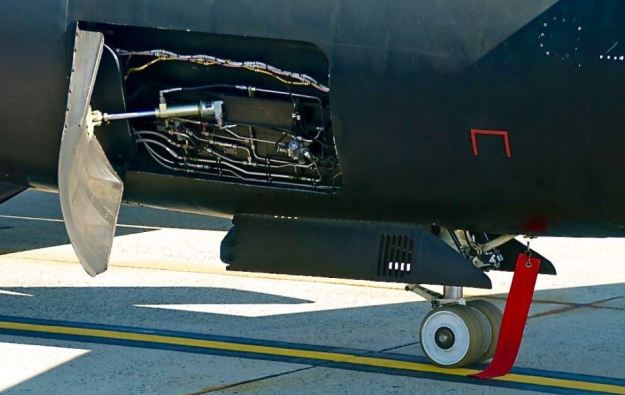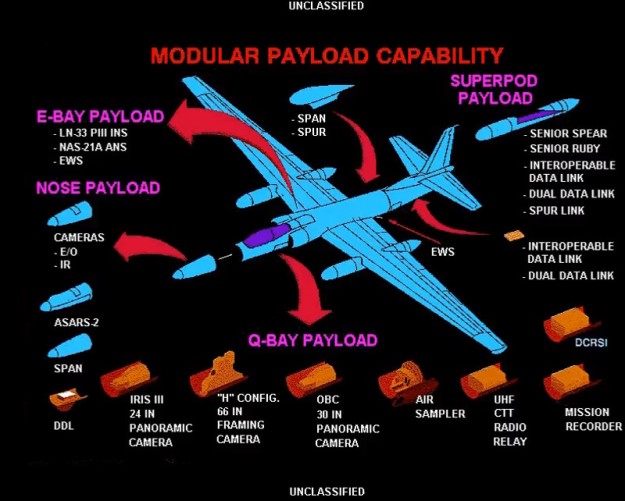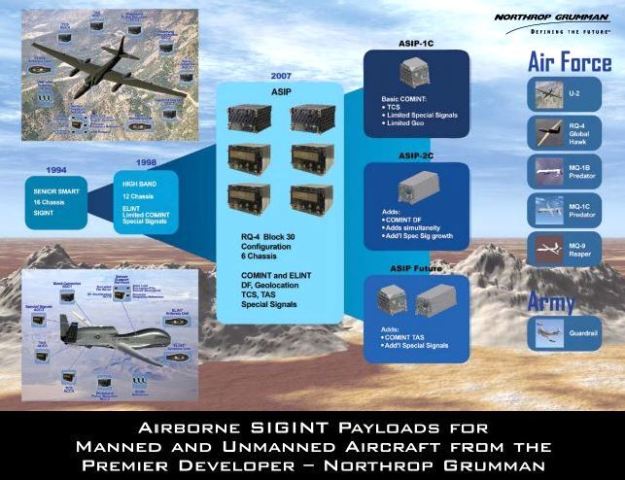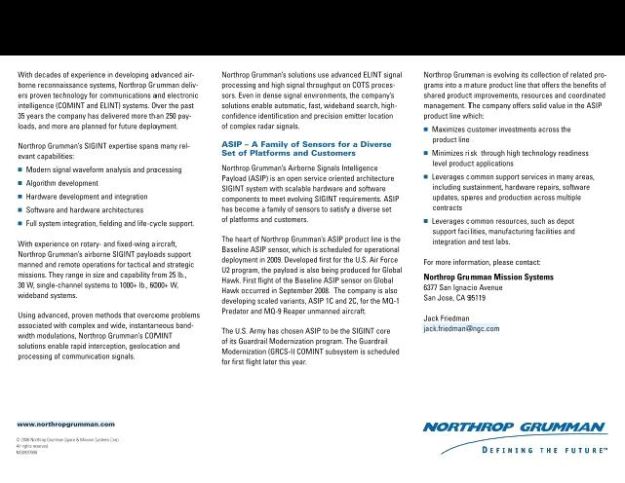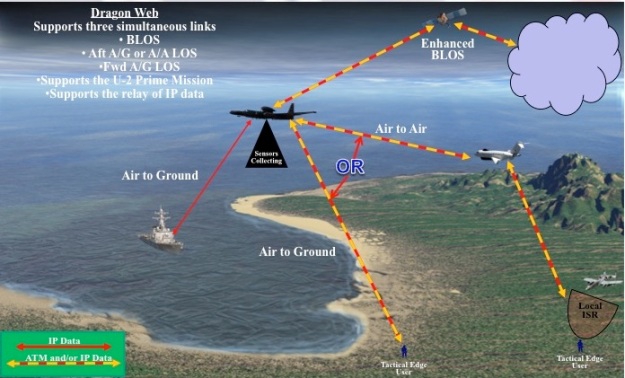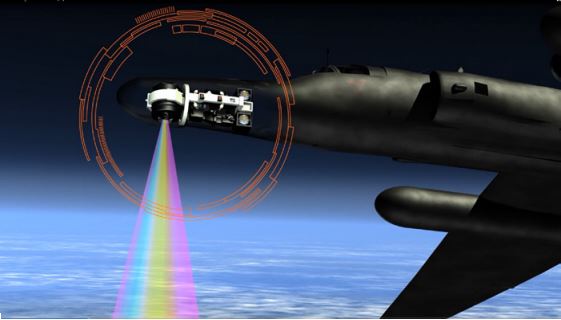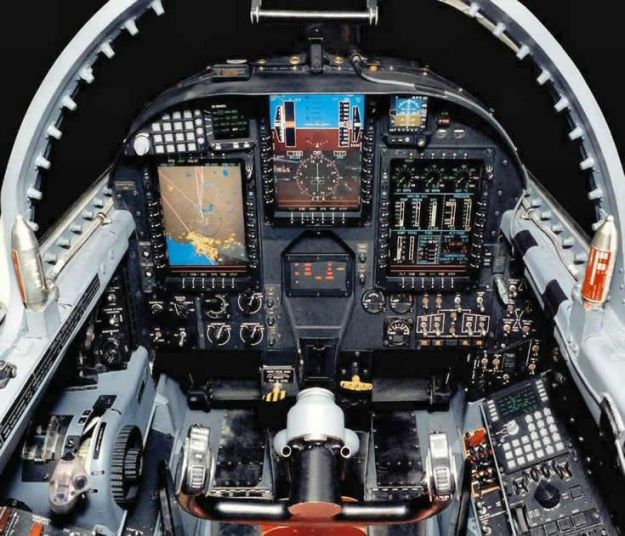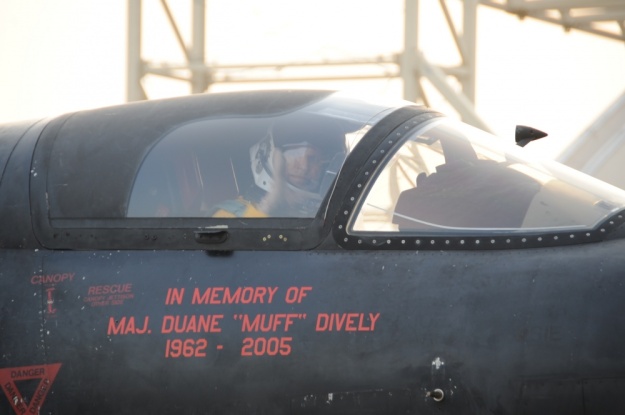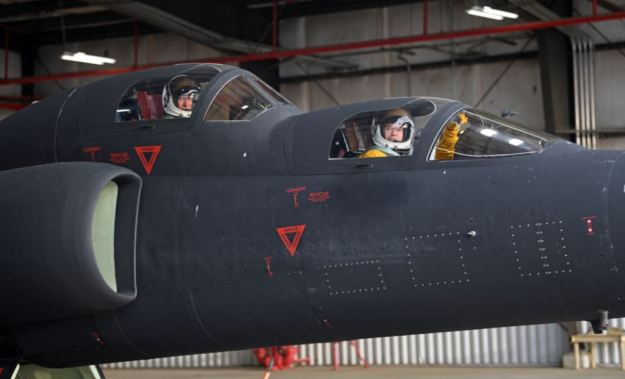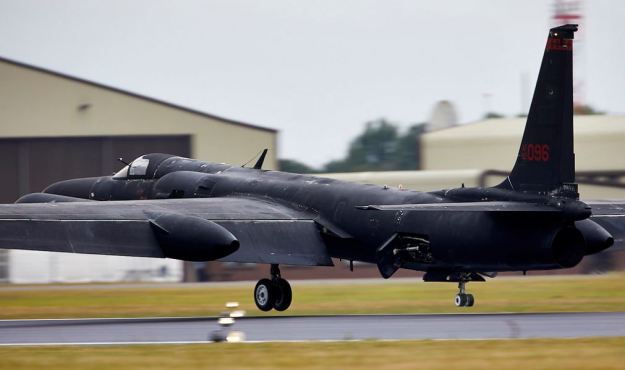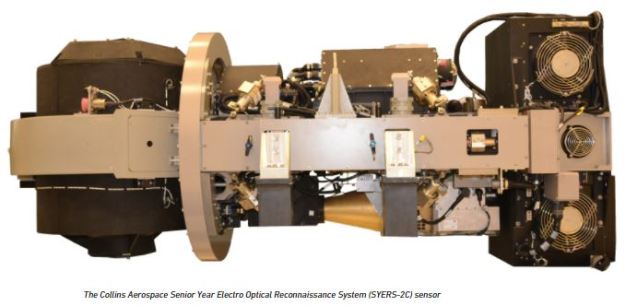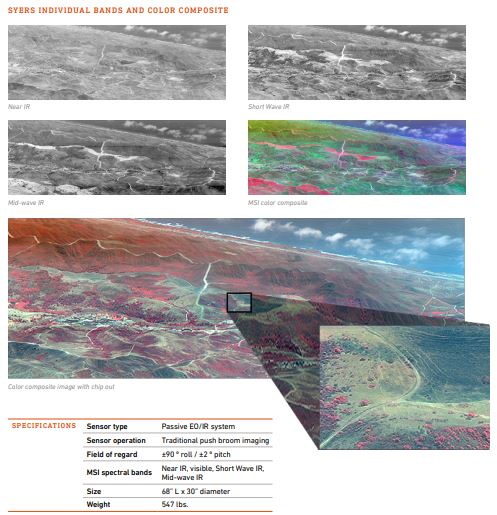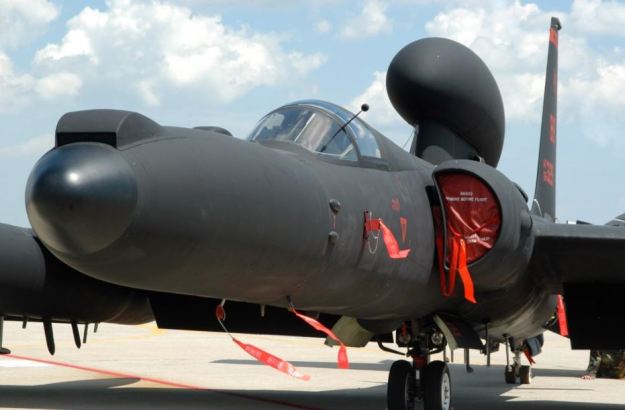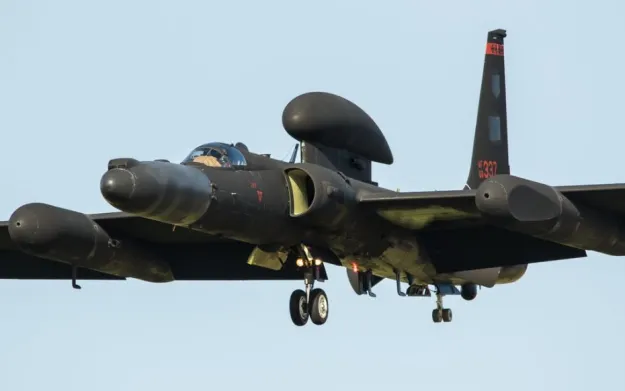The U-2S is a high-altitude reconnaissance and surveillance aircraft providing signals and imagery intelligence and has the ability to detect radar, acoustic, nuclear, chemical and biological signatures. The plane’s long, high-profile wings give the U-2 glider-like flight while the fuel-efficient engine eliminated the need for aerial refueling on long missions. Flying at 70,000 feet the pilot must wear a full pressure suit to survive.
The plane quickly earned the nickname “Dragon lady” because of its reputation of being difficult to fly even for the most experienced pilots. The combination of being light and needing to fly at high altitudes made it difficult to control. The thin air created a threshold of just 13mph between stalling and going too fast to control. Its bicycle-type landing gear requires a second U-2 pilot to follow the plane in a chase car, providing radio inputs to guide the pilot while landing.
Development and Design
The U-2 was the first aircraft in the U.S. to be designed from the ground-up as a reconnaissance plane. Before development of the U-2, the U.S. would mount cameras to fighter jets or bombers. These platforms flew at altitudes within range of Soviet air defense systems which made it impossible to safely penetrate Soviet airspace to gather intelligence on how far along their nuclear weapons technology was and the location of their bomber force.
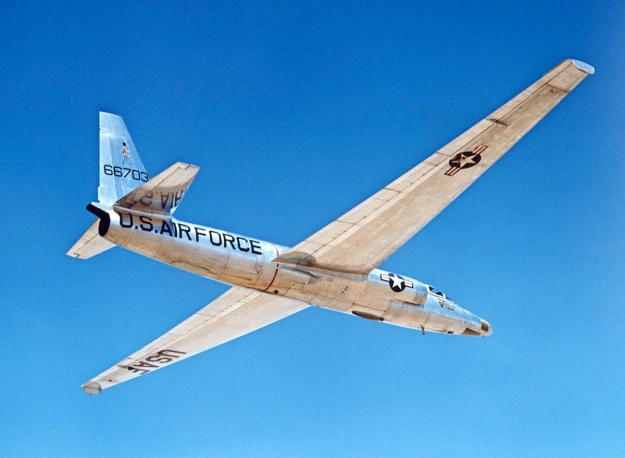
Aircraft 56-6703 was one of several Air Force and CIA-operated U-2s used to perform overflights of Cuba during the missile crisis in October 1962. Images of SS-4 intermediate range Intercontinental Ballistic Missile batteries captured from U-2s on October 14 and 15, helped confirm the Soviets were basing nuclear weapons on the Caribbean island. (Lockheed Martin photo)
The U-2 was designed by the legendary Kelly Johnson, known for designing the U.S.’s first operational jet fighter (P-80 Shooting Star) and would later design the SR-71 Blackbird along with over 40 other airframes during his time as head of Lockheed Martin’s advanced development programs, also known as Skunk Works.
Johnson’s small team of engineers developed the airframe in just 8 months, and submitted an unsolicited entry to the Air Force who was also requesting entries for high-altitude reconnaissance aircraft. The test aircraft, the CL-282, was an F-104 Starfighter with exceptionally long wings, one engine, no armor, no ejection seat, or landing gear. The Air Force at first selected the Bell X-16 which had traditional landing gear and two engines. The Intelligence Systems Panel, a civilian group advising the USAF and CIA on aerial reconnaissance convinced the Air Force and CIA to jointly fund the U-2 project.

Airman 1st Class Caleb Deaton, 5th Reconnaissance Squadron crew chief, places aircraft chocks and a main landing gear pin on a U-2 Dragon Lady during the recovery phase prior to the engine shutting down on Osan Air Base, Republic of Korea, May 15, 2014. Crew chiefs perform a post-flight inspection at the end of the flying day to ensure the aircraft is structurally fit for its next flight. (U.S. Air Force photo/Senior Airman David Owsianka)
One of the U-2’s most unique features is its landing gear. Initially, Johnson wanted the aircraft to have no landing gear–instead taking off from a wheeled dolly and landing on its belly. The flight test program became difficult to perform as the belly of the aircraft had to be repaired after every landing. The engineers instead installed a dual-wheeled main landing gear and a dual-wheeled tail wheel along the centerline of the fuselage. Flexible struts were used to support the massive 105-foot wingspan on the ground, which would fall away when the aircraft took off.
In 1994 the Air Force invested $1.7 billion modernizing the U-2. These upgrades included a 30 percent larger airframe, a new all glass cockpit, upgraded avionics, and fiber optic communication capabilities and sensor systems.
The U-2 outlasted its faster counterpart, the SR-71 Blackbird, and continues to be the go-to reconnaissance platform because of its ability to carry a large sensor payload customized to different mission requirements. Source man.dodlive.mil
The U-2 also carries a signals intelligence payload. All intelligence products except for wet film can be transmitted in near real-time anywhere in the world via air-to-ground or air-to-satellite data links, rapidly providing critical information to combatant commanders. MASINT provides indications of recent activity in areas of interest and reveals efforts to conceal the placement or true nature of man-made objects.
U-2 Avionics Upgrade Paves Way For Command And Control Role
Lockheed Martin says will position the spy plane for follow-on capability enhancements and a new lease on life at the heart of the U.S. Air Force’s ambitious Advanced Battle Management System (ABMS) command and control plan.
- Avionics Tech Refresh includes new mission computer and cockpit displays
- Update provides bridge to follow-on upgrades planned under Dragon STAR
- The ATR-configured U-2S may be used as a testbed for ABMS, Lockheed says
The Air Force’s $50 million investment in Lockheed Martin Skunk Works’ Avionics Tech Refresh (ATR) upgrade forms the latest part of a broader update plan funded through fiscal 2025 and underpins the service’s renewed intent to grow the strategic and tactical roles of the venerable intelligence, surveillance and reconnaissance (ISR) platform. It also confirms Air Force plans to keep the U-2S in service as a complement to the unmanned Northrop Grumman RQ-4 Global Hawk, reversing earlier moves to sunset the fleet.
“We’re really breathing new life into the capabilities of this platform,” says Irene Helley, U-2 program director for Lockheed Martin Skunk Works. “Most of these jets were being built in the late 1980s and ’90s and have only averaged about 17,000 flight hours, so [they] have about 80% of their airframe life remaining and still have so much more to give.”
The upgrade is “about growing the mission,” Helley adds. “We are revamping all of the avionics [in a] system [that] really hasn’t been revisited since the early 2000s.”
Lockheed says the updated avionics system provides the backbone for enhanced mission capabilities and will build a bridge to a wider series of follow-on upgrades. Internally called Dragon STAR (Sensors Technology and Avionics Refresh), this broader long-term initiative also includes additional sensor technology and systems updates.
The core of the avionics suite update is “a replacement for the existing avionics processor, which is experiencing a lot of diminishing manufacturing sources,” says Sean Thatcher, U-2 modernization program manager. Finding a replacement “is really the genesis from where the ‘tech refresh’ components came in for the aircraft,” he adds.
Other key elements include a mission computer, which “is actually a new addition to the U-2, and that’s really what starts to grow the mission itself,” Thatcher says.
The mission computer is designed to the Air Force’s open mission systems (OMS) standard, which will enable the aircraft to integrate at various security levels with systems across air, space, sea, land and cyber domains. “We’re taking the OMS standard throughout the entire suite, so everything will be able to ride within the same network. Instead of being federated and their own little system, they’ll now be able to communicate with one another to allow that broader system to be much more capable.”
Lockheed confirms the upgrade incorporates the Enterprise Mission Computer 2 (EMC2), a company-developed system nicknamed the “Einstein Box” that first publicly emerged in mid-2017, when it was tested on a modified U-2 taking part in demonstrations of advanced battlefield communications systems during a training exercise. Originally described as a “plug-and-play” system that bolts on to the avionics processor, the EMC2 also incorporates wider capabilities including dynamic mission replanning, ISR and electronic warfare capabilities.
The update also includes modern touch screen cockpit displays. “We are making those displays higher resolution for the pilots to see more and do more within the same physical area,” says Thatcher. “They will have a higher pixel resolution as well as add some touch playing abilities. And we are also looking at upgrading other cockpit systems, to bring it up to a more modern standard.”
There also will be a focus on software-driven display changes, he adds. “Pilots will be able to have more interaction with maps and other information that you would see in a modern jetliner.” The provider of the display system has not yet been announced.
The U-2S cockpit was last modernized under the Reconnaissance Avionics Maintainability Program, which was completed in 2007. As well as providing a new main avionics processor, three 6 X 8-in. multifunction displays and a secondary flight display system, the upgrade also included a BAE Systems ALQ-221 advanced defensive system that incorporated both electronic countermeasures and radar warning receivers.
Helley says the enhanced displays will enable pilots to “collect data and respond faster” as well as “allow them to make better and [more] informed decisions.” Part of this will include communicating and connecting with both fourth- and fifth-generation aircraft via multiple tactical data links such as Link 16, the F-35’s fast-switching narrow directional multifunction advanced data link and the F-22’s low-probability-of-detection and low-probability-of-intercept inflight data link. Given that none of these data links are compatible, the U-2S will communicate with all versions through the EMC2.
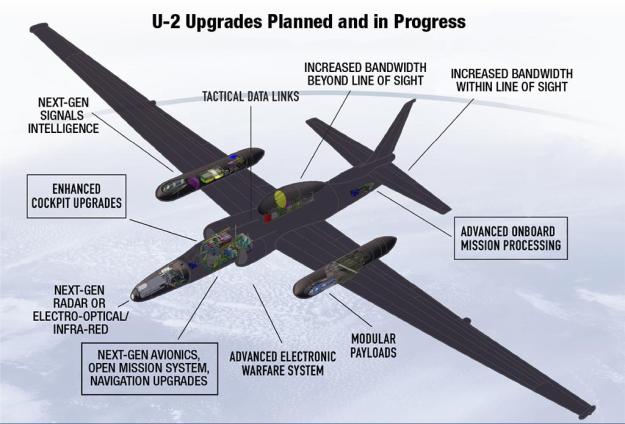
Avionics upgrades (marked in squares) will enable a raft of follow-on system updates that dovetail with others already underway. Credit: Lockheed Martin
The ATR upgrade puts the high-altitude-capable U-2 on the path toward providing the Air Force with a key node in the service’s ABMS network construct, a vision that Lockheed Martin has been steering the aircraft toward for several years. Originally conceived as the Airborne Battle Management System, the “A” now stands for “Advanced” and embraces a more comprehensive Air Force ambition to share data with and between Army, Navy and Marine Corps assets across land, sea, air and space domains. Now, as the Skunk Works begins funded work on the initial U-2 avionics modification, Lockheed also believes the company’s ability to fast-track development efforts could play a key role in early test and deployment of the ABMS.
“There’s so much talk about what the future holds for JADC2 (joint all-domain command and control),” Helley says. “Because of our ability to take the concept straight to demonstration—and then to have the capability in the field in months, rather than years—the U-2 has really become the perfect testbed to prove out those capabilities. With this avionics tech refresh effort, we’re looking to be the first fully OMS-compliant fleet out there in the Air Force today.”
The upgraded U-2 “really is going to be kind of a testbed truck for whatever those future platforms of 2030 will look like,” Helley says. “It will be able to buy down the risk of those technologies and also serve the warfighter in today’s mission abroad.” Lockheed aims to field an interim capacity beginning as early as mid-2021 and hopes to begin the whole fleet modification effort in early 2022.
Looking further ahead under the Dragon STAR plan, the ATR “bridges the way for the U-2 mission to add in next-generation sensors such as a radar or electro-optic/infrared sensor up in the nose,” Thatcher says. “We are also looking at opportunities for Sigint [signals intelligence] to be able to come in rapidly.” In addition to providing a “gateway in the sky” for tactical data links, he adds the upgrade plan “will also look at increasing the bandwidth that can go over some of the existing links as well, both on the line-of-sight and beyond-line-of-sight links.”
Many of these elements are either already underway or in planning. Flight tests of the first production version of the upgraded Raytheon ASARS-2B primary surveillance radar are due to start in 2021, although the Air Force is expected to issue a request for proposals for the follow-on ASARS-2C upgrade in fiscal 2022. The move to the -2C standard will involve upgrading the radar processor to exploit the full potential of the active, electronically scanned array antenna being introduced with the -2B.
The Air Force, Lockheed and Collins Aerospace also announced in February that flight testing and deployment of the latest variant of the Senior Year Electro-Optical Reconnaissance System (SYERS) sensor, SYERS-2C, has been completed. Meanwhile, Northrop Grumman is upgrading the Airborne Signals Intelligence Payload system that flies on the U-2 to provide cybersecurity and systems enhancements. Improvements to the BAE Systems ALQ-221 advanced defensive system are also included in the upgrade.
“We are talking about being able to host agile pods that give new mission capability at a rapid pace to support any given warfighter needs that come up,” Thatcher adds, referencing systems such as the recently developed Air Force Research Laboratory Agile Pod—a reconfigurable sensor and communications payload system.
The overall upgrade plan also addresses improvements to the aircraft’s future precision navigation and timing (PNT) capability. U-2 pilots are now being given Garmin D2 Charlie wristwatches that provide location and waypoint positioning information based on GPS and Global Navigation Satellite System signals to augment the aircraft’s navigation systems. However, for the near term, navigation enhancements will include improved map displays as part of the cockpit avionics upgrade.
Other, longer-term changes are planned, including adding a star-tracking system and replacing the current inertial navigation and GPS system. “We are definitely looking at being able to provide that [capability] into the backbone of the aircraft, too, and to not have the pilots need that reliance upon other technologies,” Thatcher says. “That’s not to say that they would ever get rid of [the wrist watch] or not want to have it as a comfort zone. But we ultimately want to have [enhanced navigation capability] baked in as the ultimate PNT source for the U-2, and also to have the ability to share that data with the other systems that are onboard the aircraft.”
Along with these operational improvements, other upgrades are in the works to address obsolescence concerns with airframe sustainment, the helmet and full-pressure suit, and Universal (formerly Unmanned) Aerospace Systems Command and Control Standard Initiative standards compliance. Beyond this, more upgrades—some of them secret—are planned, says Helley. “There are a number of other refresh modernization efforts that we are working on with our affiliates, but right now we’re still in the early planning phases of those efforts. We are not quite to the place where we can talk about them in greater detail, and a number of those items will probably remain on the classified side of the fence,” she adds.
Expanding U-2S mission capability forms one of three strategic program goals for the airframe, Helley says. “For the modernization, we’ve been growing our engineering and manufacturing team.” Another is growing the fleet. “So we’ve been working in ways to increase the rate at which we do PDM [programmed depot maintenance], as well as introducing another tail number back into the fleet,” she adds, referring to the refurbishment of tail number 80-1099. That aircraft is a single-seat model that was damaged in an August 2008 ground accident at Al Dhafra airbase, in the United Arab Emirates. Together with the rebuilt aircraft and four two-seat trainers, the planned upgraded fleet will number 31 aircraft.
“They recently loaded that tail [1099] into the main tool, which begins the main rework on the areas that were damaged,” Helley says. “So the restoration processes will be worked on over the next year. It will be immediately followed by program depot maintenance, and they’re anticipating a return to service as early as 2022.” Source aviationweek.com
U-2 receives ISR track data from F-35 in recent Orange Flag Evaluation
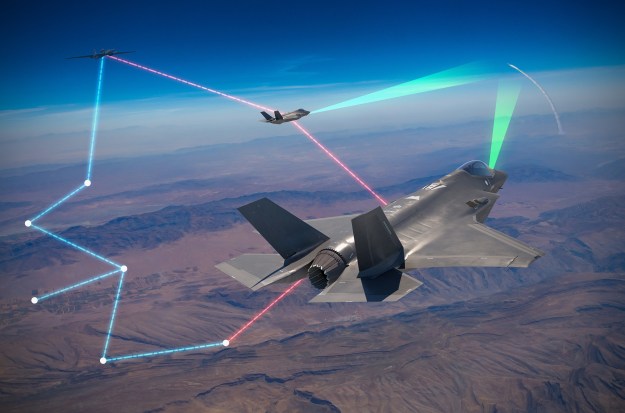
Lockheed Martin Skunk Works®, the Missile Defense Agency and the U.S. Air Force successfully connected an F-35, U-2 and a multi-domain ground station in a ground-breaking test demonstrating multi-domain operations and the secure distribution of sensitive information across multiple platforms.
U-2 spyplane relays and translates data between F-22s and F-35s
A U-2 spyplane has successfully acted as an airborne interpreter and data-link between an F-22 Raptor and five F-35 Lightning IIs. The Project Hydra test by conducted by Lockheed Martin Skunk Works, the US Missile Defense Agency and the US Air Force demonstrates for the first time how the 5th Generation fighters can share data.
Ever since the F-22 was introduced in 2005, it’s been recognized as one of the most advanced and capable fighter planes in the world. However, it isn’t very good at directly sharing data with anything other than other F-22s. As a result, F-22 pilots are forced to convey the data that the fighter’s system gathers by using old-fashioned voice radio calls.
That may seem like an example of bad engineering, but it’s really a matter of clashing requirements. While the F-22 can receive radio signals by the standards set for US and NATO systems, the F-22 can’t transmit over those systems because the F-22 is designed to be stealthy. This means that they have to use the Intra-Flight Data Link (IFDL) radio transmitter, which is extremely difficult for hostile forces to detect and zero in on.
Meanwhile, the F-35 has a similar problem when it comes to talking to the F-22, because it also needs to be stealthy, so it uses the Multifunction Advanced Data Link (MADL). This was also supposed to be retroactively installed in the F-22, but that was cancelled due to budget cuts.
Project Hydra aims to overcome this communications bottleneck by using an Open Systems Gateway (OSG) payload installed in a high-flying U-2 spyplane, which both translates and relays the data between the F-22 and the F-35s, and also with units on the ground over a Tactical Targeting Network Terminal (TTNT) link. In addition, it also sends target tracks to each fighter’s avionics and pilot displays.
For the recent test, the data was sent to the US Army Integrated Battle Command System (IBCS) Airborne Sensor Adaptation Kit (A-Kit), which relayed the data to the IBCS Tactical System Integration Laboratory (TSIL) at Fort Bliss, Texas, to support a simulated Army firing exercise using targeting data from the five F-35s. By using the U-2, the six aircraft remained connected with each other as well as global command and control units even when they were out of line-of-sight of one another.
“Project Hydra marks the first time that bi-directional communications were established between 5th Generation aircraft in-flight, while also sharing operational and sensor data down to ground operators for real-time capability,” says Jeff Babione, vice president and general manager, Lockheed Martin Skunk Works. “This next-level connectivity reduces the data-to-decision timeline from minutes to seconds, which is critical in fighting today’s adversaries and advanced threats.” Source: Lockheed Martin
F-22 Raptor: Details
Cockpit
Routinely flown at altitudes over 70,000 feet, the U-2 pilot must wear a full pressure suit similar to those worn by astronauts. The low-altitude handling characteristics of the aircraft and bicycle-type landing gear require precise control inputs during landing; forward visibility is also limited due to the extended aircraft nose and “taildragger” configuration. A second U-2 pilot normally “chases” each landing in a high-performance vehicle, assisting the pilot by providing radio inputs for altitude and runway alignment. These characteristics combine to earn the U-2 a widely accepted title as the most difficult aircraft in the world to fly.
The U-2 is powered by a lightweight , fuel efficient General Electric F118-101 engine, which negates the need for air refueling on long duration missions. The U-2S Block 10 electrical system upgrade replaced legacy wiring with advanced fiber-optic technology and lowered the overall electronic noise signature to provide a quieter platform for the newest generation of sensors.
General Electric F118-101 engine
The General Electric F118 two-spool turbofan engine is a derivative of the GE F101, which was developed for the Advanced Manned Strategic Aircraft Program (the B-1 Lancer). The F118 shares the core design of the F101 and was created by developing new low pressure systems to tailor engine performance to match the needs of the B-2 Spirit program, which was unveiled by the U.S. Air Force in 1988. The F118 is the non-afterburning version of the GE F110.
Another application for the F118 engine is the U-2S Dragon Lady high-altitude reconnaissance aircraft (spy plane). The U-2S is the result of the 1998 re-engining of U-2R aircraft with the F118-GE-101 turbofan. This greatly increased the service ceiling, range, control and safety of the aircraft.
Manufacturer: General Electric Co.
Thrust: 19,000 pounds
Overall Pressure Ratio at Maximum Power: 35.1
Thrust-to-Weight Ratio: 5.94
Compressor: Two-spool, axial flow, three-stage fan
LP-HP Compressor Stages: 0-9
HP-LP Turbine Stages: 1-2
Combustor Type: Annular
Length: 100.5 in (2.55 m)
Diameter: 46.5 in (118 cm)
Dry Weight: 3,200 lbs (1,452 kg)
Platforms: B-2A Spirit
Price/Unit Cost: Unknown
Introduced: 1988
Source fi-powerweb.com
The aircraft has the following sensor packages: electro-optical infrared camera, optical bar camera, advanced synthetic aperture radar, signals intelligence, and network-centric communication.
Sensor packages
The US Air Force (USAF) fleet of Lockheed Martin U-2 Dragon Lady spyplanes recently have completed flight testing and installation of the Collins Aerospace Senior Year Electro-Optical Reconnaissance System (SYERS-2C).
The electro-optical and infrared camera is to provide more precise, long-range tracking of stationary or moving targets in a wider range of weather conditions, says Lockheed Martin on 18 February. The sensor was also built with open mission systems architecture, which should enable easier sharing of data with fifth-generation combat aircraft, such as the Lockheed Martin F-35 Lightning II and F-22 Raptor.
The multispectral camera can use its various sensors to see in darkness, as well as through haze, smoke or clouds. The range and resolution of the camera were not disclosed.
The camera was tested and installed through a partnership between Lockheed Martin Skunk Works and Collins Aerospace.
Senior Year Electro-Optical Reconnaissance System (SYERS-2C)
“SYERS-2C represents an evolutionary step forward for the Air Force, capitalizing on a high performing, mature system to insert substantial new capabilities into the battlespace of the future,” said Kevin Raftery, vice president and general manager, ISR and Space Solutions for Collins Aerospace. “The U-2 has been the cornerstone of the Air Force’s ISR inventory and with upgrades like SYERS-2C, the system can continue to provide increasingly valuable multi-intelligence information to the warfighter for years to come.”
The ten-band, high spatial resolution SYERS-2C sensor provides unmatched ability to find, track and assess moving and stationary targets. Developed with open mission systems standards to enable command, control and data exchange with 5th generation platforms, the sensor has become a critical asset to theater commanders bringing unique advantages to joint operations across the battlespace. Source collinsaerospace.com
| General data: | |
|---|---|
| Type: Infrared | Altitude Max: 0 m |
| Range Max: 185.2 km | Altitude Min: 0 m |
| Range Min: 0 km | Generation: Infrared, 2nd Generation Imaging (1980s/1990s, LANTIRN, Litening) ) |
| Properties: Identification Friend or Foe (IFF) [Side Info], Classification [Class Info] / Brilliant Weapon [Automatic Target Aquisition], Continous Tracking Capability [Visual], Periscope/Surface Search – Advanced Processing [2000+] |
| Sensors / EW: |
|---|
| SYERS-2 – (U-2) Infrared Role: Infrared, Surveillance Camera Max Range: 185.2 km |
Source cmano-db.com
Lockheed Martin Reveals Asars-3 Imaging Radar
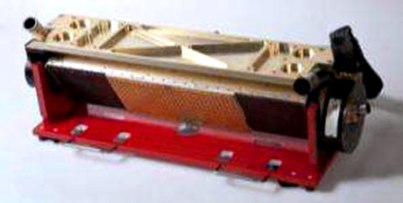
Lockheed Martin is touting its Asars-3, its Ku-band imaging and ground moving target indicator radar, as a next-generation system for small air vehicle applications.
Lockheed Martin has revealed details of its new Ku-band imaging and ground moving target indicator (GMTI) radar, describing it as a next-generation system for small air vehicle applications, manned or unmanned. Lockheed Martin’s Integrated Systems and Global Solutions (IS&GS) division has named it Asars-3, reflecting the company’s heritage as developer of the first advanced synthetic aperture radar system for the SR-71 Blackbird. Asars-2 was another X-band system, developed for the U-2 reconnaissance aircraft by Raytheon. A Lockheed Martin official told AIN that a version of Asars-3 could replace the Raytheon system on the U-2, if funding becomes available.
Lockheed Martin has already developed another version of Asars-3 for a classified program. The configuration IS&GS officials described at the Association of the U.S. Army (AUSA) Convention in Washington weighs only 165 pounds. The active-array antenna weighs just 25 pounds yet has 900 watts output. Mark Grablin, director of airborne reconnaissance systems, said that Ku-band provides much greater resolution than X-band systems and showed photo-quality images taken by the company’s Piper Navajo testbed.
X-band radars have traditionally offered longer range, but Lockheed Martin officials told AIN that larger antennas and modern processing techniques could offset that disadvantage in Ku-band systems. Grablin also told attendees that Tracer, the company’s UHF penetrating radar, has already flown on the Ikhana UAV, NASA’s version of the MQ-9 Reaper. It has been repackaged into a pod with dual antennas. He said that upcoming flight trials on a U.S. Army UH-60 “should prove that a low-frequency radar can do GMTI of targets obscured by foliage, as well as imaging,” thanks to newly developed algorithms.
Meanwhile, Northrop Grumman used the AUSA Convention to describe improvements to its small Ku-band radar. Source ainonline.com
Advanced Synthetic Aperture Radar System-2B (ASARS-2B)
The United States Air Force fiscal 2021 budget request includes $120 million for the Lockheed Martin U-2 reconnaissance aircraft, including about $48 million for the “high altitude, deep look” Advanced Synthetic Aperture Radar System-2B (ASARS-2B), $62 million for other upgrades, and nearly $10 million in overseas contingency operations funding. Raytheon builds ASARS-2B.
The $120 million Air Force request is $62 million more than appropriated last year, when ASARS-2B funds were not included.
The ASARS-2B program “replaces the front end components of the [Raytheon] ASARS-2A airborne radar to alleviate reduction in current ASARS-2A capability starting in FY21 [fiscal 2021] due to significant diminishing manufacturing sources and material shortages (DMSMS) issues,” according to the Air Force fiscal 2021 budget request.
“ASARS-2B fixes these front end DMSMS issues while advancing the AF high altitude long range ISR radar capabilities,” the request said. “ASARS-2B incorporates a new Active Electronically Scanned Array (AESA) antenna, Power Conditioning Unit (PCU), and Liquid Cooling System (LCS) while replacing the existing ASARS-2A Receiver Exciter Controller (REC) and radar data processing software on the Onboard Processor (OBP). The front-end (AESA, PCU, and LCS) together with the replaced/modified components (REC and OBP) significantly improve existing Synthetic Aperture Radar (SAR) and Ground Moving Target Indicator (GMTI) capabilities while adding new maritime capabilities. These efforts will align with back end up grades, previously referred to as ASARS-2C.”
The Air Force said that it expects to award an ASARS-2B production contract by October next year and that the initial operational capability of ASARS-2B will come by fiscal 2023.
The ASARS-2B radar includes an open systems architecture and the radar’s range is nearly double that of the previous ASARS-2A radar, Raytheon has said. ASARS-2B is to complement the Collins Aerospace Senior Year Electro-Optical Reconnaissance System (SYERS) multispectral imaging sensor.
On Feb. 18, Lockheed Martin and Collins Aerospace said that they had recently completed flight testing and deployment of SYERS-2C, a 10-band, high spatial resolution sensor.
“Developed with open mission systems standards to enable command, control and data exchange with 5th generation platforms, the sensor has become a critical asset to theater commanders bringing unique advantages to joint operations across the battlespace,” the companies said. Source aviationtoday.com
Advanced Synthetic Aperture Radar System-2 (ASARS-2)
ASARS-2 is the Advanced Synthetic Aperture Radar System carried on some variants of the Lockheed U-2 reconnaissance aircraft. The ASARS-2 system was developed in the early 1980s by Hughes Aircraft, and is currently supported by Raytheon. It is capable of detecting and accurately locating both stationary and moving ground targets; target information is transmitted via a wideband data link to a ground station. The radar is capable of producing extremely high resolution images at long range.
ASARS-2 is the Advanced Synthetic Aperture Radar System carried on some variants of the Lockheed U-2 reconnaissance aircraft. The ASARS-2 system was developed in the early 1980s by Hughes Aircraft, and is currently supported by Raytheon. It is capable of detecting and accurately locating both stationary and moving ground targets; target information is transmitted via a wideband data link to a ground station. The radar is capable of producing extremely high resolution images at long range. ASARS-2 was used extensively during Operation Desert Storm for target location and battle damage assessment. It has also been used to survey damage after various domestic disasters, including floods along the Mississippi River and the 1994 Northridge earthquake. In the late 1990s, the ASARS Improvement Program (AIP) incorporated several performance and supportability enhancements into the system. Making extensive use of commercial off-the-shelf technology, the AIP redesign increased on-board processing capability and upgraded the data link. The first of these ASARS-2A radars was delivered in 2001. Some features and technologies from the ASARS-2A system have been incorporated into the Raytheon Sentinel developed as the RAF’s Airborne STand-Off Radar (ASTOR) aircraft. Source dbpedia.org
U-2s are home based at the 9th Reconnaissance Wing, Beale Air Force Base, California, but are rotated to operational detachments worldwide. U-2 pilots are trained at Beale using five two-seat aircraft designated as TU-2S before deploying for operational missions.
General characteristics
Primary function: high-altitude reconnaissance
Contractor: Lockheed Martin Aeronautics
Power plant: one General Electric F118-101 engine
Thrust: 17,000 pounds
Wingspan: 105 feet (32 meters)
Length: 63 feet (19.2 meters)
Height: 16 feet (4.8 meters)
Weight: 16,000 pounds
Maximum takeoff weight: 40,000 pounds (18,000 kilograms)
Fuel capacity: 2,950 gallons
Payload: 5,000 pounds
Speed: 410 mph
Range: more than 7,000 miles (6,090 nautical miles)
Ceiling: above 70,000 feet (21,212+ meters)
Crew: one (two in trainer models)
Unit cost: classified
Initial operating capability: 1956
Inventory: active force, 33 (5 two-seat trainers and two ER-2s operated by NASA); Reserve, 0; ANG, 0
(Current as of September 2015)
Source af.mil
Main material source military.com
Images are from public domain unless otherwise stated
Main image by Nick Collins
Updated Sep 16, 2021


